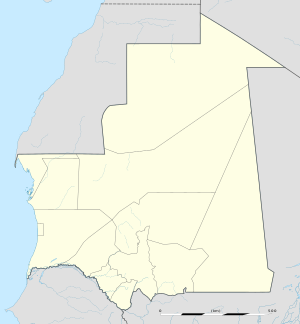Awdaghust
| Aoudaghost | |
|---|---|
| Site of mediaeval town | |
| Location in Mauritania | |
| Coordinates: 17°25′N 10°25′W / 17.417°N 10.417°WCoordinates: 17°25′N 10°25′W / 17.417°N 10.417°W | |
| Country |
|
Aoudaghost (also transliterated as Awadaghust, Awdughast, Awdaghusht and Awdhaghurst) is a former Berber town in Hodh El Gharbi, Mauritania. It was an important oasis town at the southern end of a trans-Saharan caravan route that is mentioned in a number of early Arabic manuscripts. The archaeological ruins at Tegdaoust in southern Mauritania are thought to be the remains of the medieval town.
The earliest mention of Aoudaghost is by al-Yaqubi in his Kitab al-Buldan completed in 889-890 in which he described the town as being controlled by a tribe of the Sanhaja and situated 50 stages south of Sijilmasa across the Sahara desert. "It is the residence of their king who has no religion or law. He raids the land of the Sudan who have many kingdoms." From Ibn Hawqal writing in around 977 we learn that the distance from Aoudaghost to Ghana (presumably the capital of the Empire) was 10 days' journey for a lightly loaded caravan. Ibn Hawqal wrote that the "king of Awdaghurst maintains relations with the ruler of Ghana" which suggests that at that time Aoudaghost was not part of the Ghana Empire. He also mentions the trade in gold and writes that the king of Ghana is very rich because of his stocks of gold but that the kings of Ghana and Kugha "stand in pressing need of [the goodwill of] the king of Awdaghust because of the salt which comes to them from the lands of Islam."
The only detailed description that we have for the town is given by al-Bakri in his Book of Routes and Realms which was completed in 1068. Al-Bakri made use of earlier sources and it is likely that his description of Aoudaghost comes from the writings of Muhammad b. Yusuf al-Warraq (904-973) whose own account has not survived:
Then to Awdaghust which is a large town, populous and built on sandy ground, overlooked by a big mountain, completely barren and devoid of vegetation. ... there is one cathedral mosque and many smaller ones ... Around the town are gardens with date palms. Wheat is grown there by digging with hoes, and it is watered with buckets ... Excellent cucumbers grow there, and there are a few small fig trees and some vines, as well as plantations of henna which produce a large crop ... [there are] wells with sweet water. Cattle and sheep are so numerous... Honey ... is abundant, brought from the land of the Sudan. The people of Awdaghust enjoy extensive benefits and huge wealth. The market there is at all times full of people... Their transactions are in gold, and they have no silver. Most of the inhabitants ... are natives of Ifriqiya [Tunisia] ... but there are also a few people from other countries ... [They own] slaves so numerous that one person from among them might possess a thousand servants or more.
...
Wikipedia

